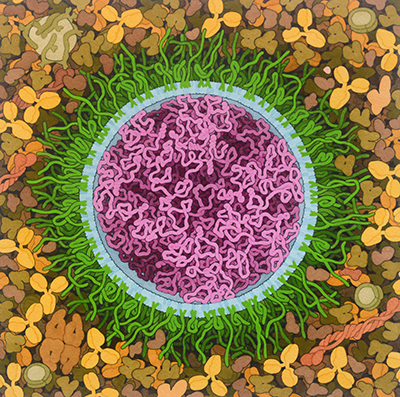Molecular Landscapes by David S. Goodsell
SARS-CoV-2 mRNA Vaccine, 2020
Acknowledgement: Illustration by David S. Goodsell, RCSB Protein Data Bank; doi: 10.2210/rcsb_pdb/goodsell-gallery-027
Messenger RNA (mRNA) vaccines developed for the COVID-19 pandemic are composed of long strands of RNA (magenta) that encode the SARS-CoV-2 spike surface glycoprotein enclosed in lipids (blue) that deliver the RNA into cells. Several different types of lipids are used, including familar lipids, cholesterol, ionizable lipids that interact with RNA, and lipids connected to polyethylene glycol chains (green) that help shield the vaccine from the immune system, lengthening its lifetime following administration. In this idealized illustration, all of the lipids are arranged in a simple circular bilayer that surrounds the mRNA and the PEG strands have both extended and folded conformations. In reality, the structure may be less regular, as suggested in the NanoLetters paper included below. Learn more about how this vaccine works in Resources to Fight the COVID-19 Pandemic.
References
Corbett, K. S., et al. (2020) SARS-CoV-2 mRNA vaccine designs enable by prototype pathogen preparedness. Nature 586, 567-571.
Eygeris, Y., et al. (2020) Deconvoluting lipid nanoparticle structure for messenger RNA delivery. Nano Letters 20, 4543-4549.




